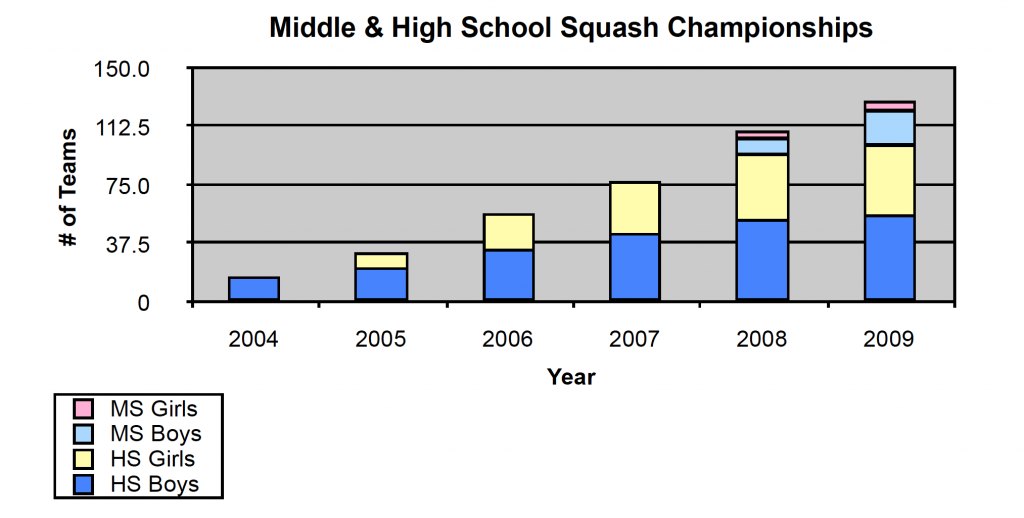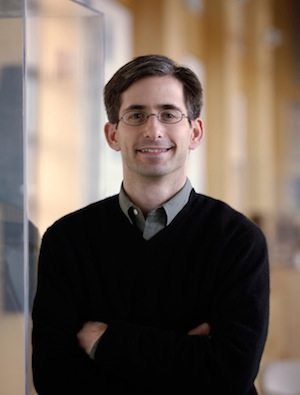By Kevin Klipstein
Looking back just three seasons ago to 2005-2006, the U.S. High School Team Championships was in its third year. It had over 50 teams for the first time. The girls’ division had been introduced only the year before. The launch of the U.S. Middle School Championships was still two seasons away.
At the time, U.S. SQUASH had no official connection to either the New England Interscholastic Squash Association (NEISA has 77 teams) or the College Squash Association (CSA has over 100 teams). All three organizations operated independently. Match results were recorded for junior tournaments, but not for league matches, so middle and high school league play operated in a separate squash world from the rest of junior squash.
 Today, we see a very different picture. At the 2009 U.S. High School Team Championships, more than 100 club and varsity programs fielded 8-player teams, making it the largest squash tournament in the world. The number of teams in the U.S. Middle School Championships doubled this year to nearly 30 from its inaugural year. No, the chart below is not upside down, it’s what we believe to be the most significant potential driver for growth of the sport in the US.
Today, we see a very different picture. At the 2009 U.S. High School Team Championships, more than 100 club and varsity programs fielded 8-player teams, making it the largest squash tournament in the world. The number of teams in the U.S. Middle School Championships doubled this year to nearly 30 from its inaugural year. No, the chart below is not upside down, it’s what we believe to be the most significant potential driver for growth of the sport in the US.
With some teams at public schools in CT, NY and NJ receiving varsity status this year, the result of efforts of passionate coaches and parents, tax dollars are finally being committed to support and develop squash. U.S. SQUASH now has strategic partnerships with NEISA and the CSA, strengthening the integration required to support the sport.
Match records for junior players include league results, and are 10 pages deep for many. Junior ranking exposures count for several leagues beyond NEISA, including the newly formed public school league formed in Fairfield and Westchester Counties, the Fairwest Public School Squash Association.
Darien High School is one member of this new league, and they competed in the Boys’ Division III of the 2009 U.S. High School Championships this year. Sitting next to two girls from the Hackley Girls’ team (which fielded a team for the first time this year), I couldn’t help noticing how intently they were watching the No. 1 Darien Boys’ team player. But it wasn’t for the reason you might think. Playing No. 1 and No. 2 for the Darien Boys’ team were the sister duo of Leslie and Madeleine Gill, and they were battling against Conestoga High School’s team which has been a beneficiary of a U.S. SQUASH Junior Endowment Fund grant and recently received varsity status.
The Hackley girls seemed so proud and inspired by the Gill girls, and could only say things like, “She’s aaawesome.” During the match, one of the girls turned to me and asked incredulously, “They let them play?”
U.S. SQUASH seeks to provide as many opportunities for juniors to play squash as possible, whether they be from urban or community programs, middle or high school teams, Junior Championship Tour players or National Team candidates.
U.S. SQUASH provides opportunities for juniors to:
- Play tournaments at the best collegiate venues
- Earn a U.S. ranking via school programs and individually
- Access the sport by funding community and urban programs
- Represent the U.S. at international competitions
- Continue their playing careers in college
U.S. Junior Squash certainly has come a long way in just three years, and there are only signs of this growth accelerating.
With the next round of the Division III consolation on the line, one of the Gill girls won, tying the match 3-all. The last match on between the No. 1’s went four games, and Conestoga prevailed. It was as exciting as squash gets, with a passionate and vocal crowd, high quality squash, and outstanding sportsmanship.
Yes, we let them play, and they played very well, all 816 of them.



